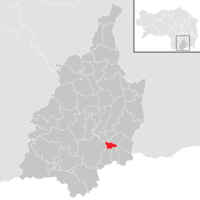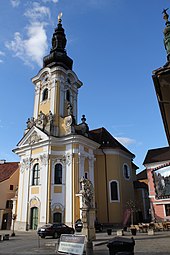Ehrenhausen
|
Ehrenhausen ( capital of a market town ) village ( main town of the municipality ) Ehrenhausen cadastral community |
||
|---|---|---|
|
|
||
| Basic data | ||
| Pole. District , state | Leibnitz (LB), Styria | |
| Judicial district | Leibnitz | |
| Pole. local community | Ehrenhausen on the Weinstrasse | |
| Coordinates | 46 ° 43 '23 " N , 15 ° 35' 11" E | |
| height | 258 m above sea level A. | |
| Residents of the village | 1108 (January 1, 2020) | |
| Building status | 352 (2001 ) | |
| Area d. KG | 3.04 (2017) | |
| Post Code | 8461 Ehrenhausen | |
| Statistical identification | ||
| Locality code | 15441 | |
| Cadastral parish number | 66107 | |
| Counting district / district | Ehrenhausen (61 049 000) | |
 Location of the former municipality in the Leibnitz district until 2014 |
||
| Independent municipality until the end of 2014 Source: STAT : Local directory ; BEV : GEONAM ; GIS-Stmk |
||
Ehrenhausen ( Slovenian Ernovž ) is a place in Styria with 1108 inhabitants (as of January 1, 2020). It gave its name to a market town in the judicial district or district of Leibnitz . On January 1, 2015, this municipality was merged with the municipalities Berghausen , Ratsch an der Weinstrasse and Retznei as part of the Styrian municipal structural reform , the new municipality bears the name Ehrenhausen an der Weinstrasse .
geography
The town and castle Ehrenhausen are on the Mur in southeastern Styria ( Austria ) south of Leibnitz near the border with Slovenia at 258 m above sea level. A.
Ehrenhausen consists of the only cadastral community of the same name or locality.
Starting from Graz , Ehrenhausen can be reached in around 45 to 50 minutes by train using the regional train or S-Bahn in the direction of Spielfeld - Straß .
Ehrenhausen is also known as the gateway to the South Styrian Wine Route .
Neighboring places
| Retznei | Vogau | |
| Gamlitz |

|
matchfield |
| Berghausen and Ratsch an der Weinstrasse |
history
The area around Ehrenhausen has been populated since the Bronze Age. Presumably in the 11th century, the Counts of Sponheim built a defense structure at the crossing over the Mur. The castle was included in the fortification belt on the border against the Hungarians at an early stage . At the same time, the castle had to secure the trade route on the Mur plain into the Drautal and the entrances to the Gamlitztal and the Leutschachertal . A settlement was established at an early stage under the protection of the castle.
As a gift from the sons of Count Engelbert the Elder of Sponheim , the castle came into the possession of the St. Paul Monastery in Carinthia around 1100 . The castle was first mentioned as Ernhus in 1240 in a deed of donation from Duke Friedrich II of Austria . Around 1260 the fiefdom of the castle came to Friedrich von Pettau , who appointed his knights as burgraves . In 1285 Ehrenhausen is referred to as Hovs Erenhovsen .
In 1267 Herword the Elder von Ehrenhausen and in 1293 Herword the Younger von Ehrenhausen were appointed burgraves. In 1360 the fief of the castle fell back to the monastery of St. Paul. Duke Rudolf IV of Austria then lent the St. Paul Monastery and the Ehrenhausen Fortress to his brother. After his death in 1365, the property returned to the Lords of Pettau . In October 1437, Duke Albrecht V of Austria again enfeoffed the Lords of Pettau with Ehrenhausen. After the death of the last male Pettauer, the fiefdom passed to his daughters Countess Anna von Schaunberg and Agnes von Stubenberg .
On 24 April 1543 had to Count Georg von Schaubergwerk the castle and the Meiereihof to Christoph von Eggenberg from the Radkersburger line of Eggenberger sell. The market Ehrenhausen allowed Ferdinand I. by decree of 16 June 1556 hold two fairs, a market judge was first mentioned in 1574. In 1583 the plague raged in and around Ehrenhausen. Emperor Ferdinand II raised Ehrenhausen to market in 1624. In the following years the castle was converted into a palace.
In 1646 the market and palace changed hands to the Prince of Eggenberg from the Graz line. On April 19, 1693, the mausoleum for Ruprecht von Eggenberg was inaugurated , and construction has been ongoing since 1609. After lengthy negotiations between the Ehrenhausen rulers and the episcopal ordinariate , a contract was signed on November 9, 1749, made by Princess Maria Charlotte zu Eggenberg and the Salzburg Archbishop Leopold II. Freiherr von Firmian , on the establishment of a separate parish for Ehrenhausen. As early as 1751 the baroque parish and pilgrimage church of Sorrowful Mother Mary was rebuilt in place of a small church from the 16th century. The lordship of Ehrenhausen passed into the possession of the Counts of Leslie by inheritance in 1755. In 1804 the Counts of Attems became the owners of Ehrenhausen. Since the 19th century, the owners changed frequently. Between French troops and the second Grazer Landwehr - Battalion occurred in Ehrenhausen 1809 to a fight.
The abolition of the manorial lords took place in 1848. The local community as an autonomous body was established in 1850. At that time there was a doctor, a surgeon, a poor institute (poor house), a two-class elementary school and a wagon master's office in Ehrenhausen. Prince Archbishop Theodor Kohn von Olmütz bequeathed the Eggenberg mausoleum, which belonged to him for eleven years until his death in 1915, to the State of Styria. His grave monument is in the mausoleum.
After the annexation of Austria in 1938 , the community became part of the Reichsgau Steiermark. From 1945 to 1955 it was part of the British zone of occupation in Austria.
traffic
The Ehrenhausen stop is on the southern railway . Trains of the S5 S-Bahn in the direction of Graz or Spielfeld-Straß stop, which run every hour. The interval is compressed during rush hour.
Culture and sights
On his famous walk to Syracuse in 1802 , the German travel writer Johann Gottfried Seume came to Ehrenhausen, "a very pretty town that lives up to its name".
Today most of the visitors come due to the location of the place on the South Styrian Wine Route. In addition, the Murradweg leads through Ehrenhausen.
The most famous sights in town are:
- Parish and pilgrimage church "Sorrowful Mother Mary", built in Rococo style in the years 1752–1755
- Ehrenhausen Castle , 16th century (parts from the 12th century), on a hill above the village
- Ehrenhausen Mausoleum , built between 1609 with interruptions until around 1693, possibly planned by Giovanni Pietro de Pomis , is one of the main works of Mannerist architecture in Austria
- Georgi Castle from the 19th century, on the opposite side of Ehrenhausen Castle
leisure
Ehrenhausen is located on the 365 km long Mur Cycle Path and is also the destination of the demanding Welschlauf ( 1440 meters in altitude must be overcome over a marathon distance ).
politics
coat of arms
The municipal coat of arms was awarded with effect from May 1, 2005.
Blazon (coat of arms description):
- "In silver a raven soaring to the left."
Personalities
Honorary citizen
- 1977 Johann Bammer (1922–2017), Provincial Councilor
- 1981 Hans Gross (1930–1992), Deputy Governor
- Peter Stauder (1940–2018), local historian
Sons and daughters of the market town
- Max de Crinis (1889–1945), psychiatrist and neurologist , SS-Standartenführer
Personalities associated with Ehrenhausen
- Ruprecht von Eggenberg (1546–1611), general
- Wolff von Eggenberg († 1615), officer
- Theodor Kohn (1845–1915), Archbishop of Olomouc , professor of canon law
- Franz Kortschak (1908–1986), politician of the ÖVP , member of the National Council 1949–1959, winegrower
literature
- Peter Stauder: Ehrenhausen. Ehrenhausen 1990
- Peter Stauder: Ehrenhausen. Old, new, interesting. 2 volumes, Ehrenhausen 2010
Web links
- www.ehrenhausen.gv.at Website of the municipality
- 61005 - old parish Ehrenhausen. Community data, Statistics Austria .
Individual evidence
- ↑ Statistics Austria: Population on January 1st, 2020 by locality (area status on January 1st, 2020) , ( CSV )
- ↑ Announcement of the Styrian state government of September 12, 2013 on the unification of the market community Ehrenhausen and the communities Berghausen, Ratsch an der Weinstrasse and Retznei, all political district Leibnitz. Styrian State Law Gazette of October 14, 2013. No. 102, 28th issue. P. 556.
- ↑ ÖBB-Personenverkehr AG Kursbuch current (PDF file 108 kB, accessed on December 16, 2009)
- ^ Johann Gottfried Seume: Walk to Syracuse in 1802 , freely available online at [1] , page 59
- ↑ State Law Gazette Styria No. 36/2005







